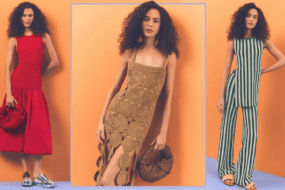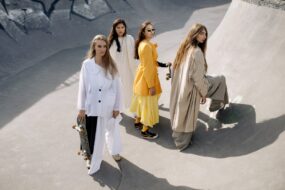
As we move through the 2020s, it’s easy to forget how quickly fashion evolves. What was considered revolutionary in 2010 feels like it belongs in a different era today. Over the past decade, fashion has undergone significant transformations, driven by social media, political shifts, technological advancements, and an increased awareness of environmental sustainability. This retrospective will look back at the key trends that shaped the fashion industry between 2010 and 2020.
1. Fast Fashion’s Dominance
In the 2010s, fast fashion became even more dominant than before. Brands like Zara, H&M, and Forever 21 capitalized on the consumer desire for low-cost, high-turnover clothing. This model allowed fashion to change rapidly and provided consumers with endless new options. By leveraging trends seen on social media and runway shows, fast fashion made it possible for anyone to be on top of the latest looks within weeks or even days.
While the industry thrived, it also faced immense criticism for its environmental impact, exploitation of workers, and contribution to consumer culture that encouraged overconsumption. The rise of fast fashion played a pivotal role in how clothing became a commodity and how much influence it began to exert on our daily lives.
2. Athleisure: The Blurring of Comfort and Style
One of the most significant trends of the decade was the rise of athleisure. This trend combined comfort with style, offering clothing that could transition seamlessly from the gym to casual settings. Activewear brands such as Lululemon, Nike, and Adidas became more than just sportswear; they became key players in the fashion industry. Athleisure went beyond just leggings and sneakers. It incorporated sweatshirts, joggers, and stylish sports bras that could be worn in both athletic and casual contexts.
This shift was not only a response to the growing health and fitness trend but also to changing work environments. As remote work became more common and workplace dress codes became more relaxed, athleisure offered a perfect blend of comfort and style that appealed to a wide audience. The trend also carried with it a cultural shift toward prioritizing wellness and self-care, turning activewear into a symbol of personal investment in health.
3. Sustainability and Slow Fashion
As the environmental toll of fast fashion became more evident, a counter-movement began to rise—slow fashion. Consumers became more conscious of the environmental impact of their purchases, and a growing demand for sustainable fashion emerged. This was a pivotal moment for brands like Patagonia, Stella McCartney, and Reformation, who championed eco-friendly materials, ethical labor practices, and reduced waste.
Sustainable fashion is rooted in creating long-lasting, high-quality garments made from organic or recycled materials. The push for sustainability led to innovations such as biodegradable fabrics, vegan leather, and closed-loop production systems that aimed to minimize the waste that contributes to landfill overflow.
Second-hand clothing also enjoyed a revival during this period, with platforms like Depop, Poshmark, and ThredUp making it easier than ever to shop vintage or pre-owned items. Renting clothing for special occasions became popular as well, offering an alternative to buying new garments that may only be worn once or twice.
4. The Rise of Streetwear
In the 2010s, streetwear evolved from a niche subculture to a mainstream fashion phenomenon. Pioneered by brands like Supreme, Off-White, and Fear of God, streetwear was born out of urban culture, skateboarding, and hip-hop. It became an expression of individual style, and its popularity skyrocketed, driven by the influence of celebrities like Kanye West, Travis Scott, and Virgil Abloh, as well as collaborations between luxury brands and streetwear labels.
One of the key features of streetwear is its democratic nature—anyone, regardless of their socioeconomic status, could participate in the trend by incorporating sneakers, graphic tees, and hoodies into their wardrobes. The combination of high-end fashion with casual wear democratized style, blending luxury and street culture in ways that had never been done before.
Streetwear also marked a shift toward exclusivity and hype. Limited edition drops, collaborations, and resale platforms like StockX created a market where scarcity became a driving force behind fashion trends. The price of a pair of sneakers or a hoodie could sometimes escalate to thousands of dollars, solidifying streetwear as not just a trend but a financial asset.
5. Social Media’s Influence on Fashion
The explosion of social media in the 2010s had a profound impact on how fashion was consumed and perceived. Instagram, in particular, became the primary platform for fashion influencers, celebrities, and designers to showcase their style and collections. The platform’s visual nature made it ideal for promoting fashion trends, and it allowed everyday people to become style icons in their own right.
Fashion blogs also played a crucial role in shaping trends. Influencers such as Chiara Ferragni and Danielle Peazer were able to turn their personal style into brands, making them key players in the industry. Social media allowed individuals to share their outfits and gain recognition, creating an environment where trends were not solely dictated by designers or fashion houses.
The rise of influencers and social media-driven marketing also contributed to the accelerated pace of fashion cycles. New trends could spread around the world in an instant, and the demand for new items often outpaced traditional fashion seasons.
6. Gender Fluidity and Unisex Clothing
Another defining trend of the decade was the push toward gender fluidity and the rejection of traditional gender norms in fashion. High-profile figures like Harry Styles, Billie Eilish, and Jaden Smith challenged conventional ideas of masculinity and femininity through their clothing choices. The fashion industry began to embrace unisex collections and non-binary representations.
This shift was reflected in runway shows and advertising campaigns that featured models of various gender identities. Brands like Gucci, Balenciaga, and Louis Vuitton showcased gender-neutral pieces, and smaller independent labels also embraced inclusive designs that transcended the binary.
The growing demand for gender-inclusive fashion spoke to a larger societal shift toward acceptance and individuality, allowing people to express themselves more freely without the constraints of traditional gender expectations.
7. The Return of ’90s and Early 2000s Fashion
Fashion tends to be cyclical, and the 2010s saw the resurgence of trends from the 1990s and early 2000s. Many of the fashion icons of the ‘90s—such as Kate Moss, Naomi Campbell, and the Spice Girls—became references for a new generation of fashion lovers. Key elements of ‘90s style, such as slip dresses, chokers, platform shoes, and oversized flannel shirts, made their return. Brands like Tommy Hilfiger, Calvin Klein, and Champion also enjoyed comebacks, with their nostalgic appeal being embraced by Gen Z and millennials alike.
Similarly, the early 2000s saw the revival of low-rise jeans, cargo pants, and graphic tees. Celebrities like Britney Spears and Paris Hilton became style icons for a new generation, influencing young people to embrace this playful, carefree aesthetic.
The revival of ‘90s and 2000s fashion reflected the desire for nostalgia and a return to simpler times. It also marked the blending of retro elements with modern sensibilities, creating a hybrid style that felt fresh and contemporary.
8. Technology and Fashion: Wearables and Digital Fashion
As technology advanced, the intersection of fashion and tech became more prominent in the 2010s. The introduction of smartwatches, fitness trackers, and other wearables brought functionality to fashion in ways that were once imagined only in science fiction.
Fashion houses also began exploring digital fashion, where clothing existed solely in virtual spaces. Designers like Balenciaga and The Fabricant experimented with digital collections, offering a glimpse into the future of fashion where garments may exist only as data. The increasing use of virtual reality and augmented reality also influenced fashion, as consumers could now try on clothes virtually before making a purchase.
The role of technology in fashion continues to grow, offering a glimpse into how our wardrobes might evolve in the years to come.
Conclusion
The 2010s was a decade of dramatic change in the fashion world. From the rise of fast fashion and streetwear to the increasing focus on sustainability and inclusivity, the last ten years have seen fashion become more diverse, dynamic, and accessible. At the same time, technology has transformed how we shop, interact with brands, and envision the future of clothing.
As we look ahead to the 2020s, it’s clear that fashion will continue to evolve, influenced by environmental concerns, cultural shifts, and technological advancements. What’s certain is that the trends that defined the last decade will leave a lasting impact on the industry for years to come.






















